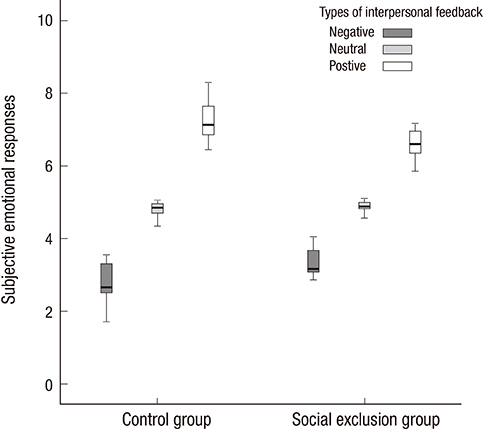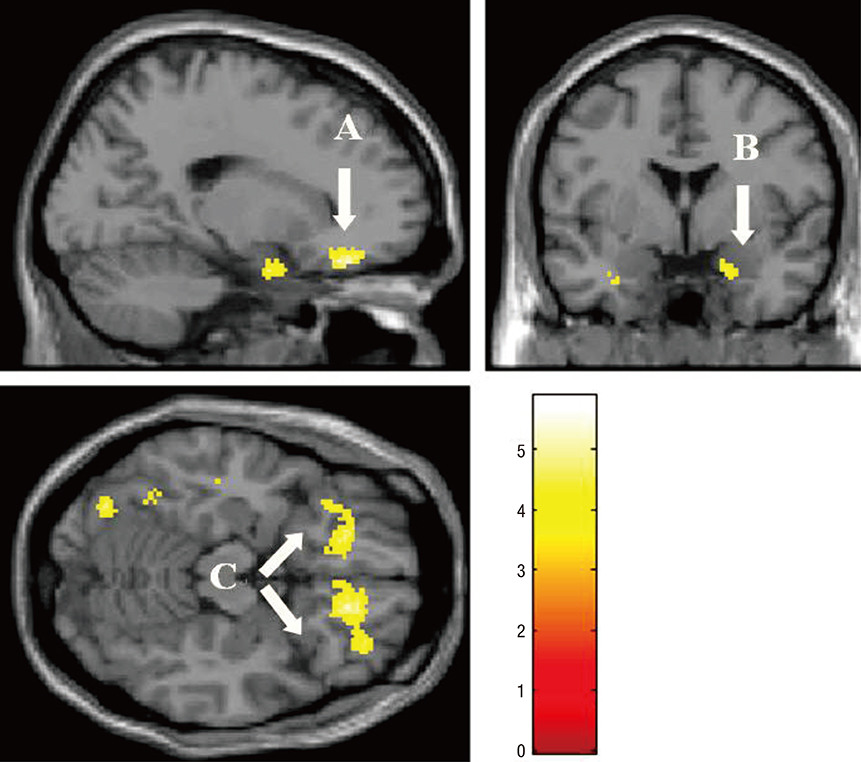J Korean Med Sci.
2014 Sep;29(9):1293-1300. 10.3346/jkms.2014.29.9.1293.
Neural Changes Associated with Emotion Processing in Children Experiencing Peer Rejection: A Functional MRI Study
- Affiliations
-
- 1Department of Pediatrics, College of Medicine, The Catholic University of Korea, Seoul, Korea. pedkyh@catholic.ac.kr
- 2Department of Psychiatry, College of Medicine, The Catholic University of Korea, Seoul, Korea.
- KMID: 1794610
- DOI: http://doi.org/10.3346/jkms.2014.29.9.1293
Abstract
- This study was performed to investigate differences between children who did and did not experience peer rejection in psychological state through surveys and in emotion processing during an interpersonal stress challenge task to reflect naturalistic interpersonal face-to-face relationships. A total of 20 right-handed children, 10 to 12 yr of age, completed self-rating questionnaires inquiring about peer rejection in school, depression, and anxiety. They then underwent an interpersonal stress challenge task simulating conditions of emotional stress, in reaction to positive, negative and neutral facial expression stimuli, using interpersonal feedbacks, and functional magnetic resonance imaging (FMRI) for an analysis of neural correlates during the task. Ten were the peer-rejection group, whereas the remainder were the control group. Based on the behavioral results, the peer-rejection group exhibited elevated levels of depression, state anxiety, trait anxiety and social anxiety as compared to the control group. The FMRI results revealed that the peer-rejection group exhibited greater and remarkably more extensive activation of brain regions encompassing the amygdala, orbitofrontal cortex and ventrolateral prefrontal cortex in response to negative feedback stimuli of emotional faces. The different brain reactivities characterizing emotion processing during interpersonal relationships may be present between children who do and do not experience peer rejection.
MeSH Terms
Figure
Reference
-
1. Olweus D. Bullying at school: what we know and what we can do. Oxford: Blackwell Publishers;1993.2. Shin SW, Kwon SW, Shin MS, Cho SC. A survey of the psychosis among school violence victims. J Child Adolesc Psychiatry. 2000; 11:124–143.3. Kahng UH, Lee EH, Yim EJ. The bullying and psyhological traits. Korean J Couns Psychother. 2002; 14:445–460.4. Masten CL, Eisenberger NI, Borofsky LA, Pfeifer JH, McNealy K, Mazziotta JC, Dapretto M. Neural correlates of social exclusion during adolescence: understanding the distress of peer rejection. Soc Cogn Affect Neurosci. 2009; 4:143–157.5. Eisenberger NI, Lieberman MD, Williams KD. Does rejection hurt? an FMRI study of social exclusion. Science. 2003; 302:290–292.6. Rigby K. Consequences of bullying in schools. Can J Psychiatry. 2003; 48:583–590.7. Williams KD. Ostracism. Annu Rev Psychol. 2007; 58:425–452.8. Masten CL, Eisenberger NI. Exploring the experience of social rejection in adults and adolescents: a social cognitive neurosicence perspective. In : Harris MJ, editor. Bullying, rejection and peer victimization: a social cognitive neurosicence perspective. New York: Springer publishing company;2009. p. 53–78.9. Hubbard JA. Emotion expression processes in children's peer interaction: the role of peer rejection, aggression, and gender. Child Dev. 2001; 72:1426–1438.10. Killgore WD, Yurgelun-Todd DA. Unconscious processing of facial affect in children and adolescents. Soc Neurosci. 2007; 2:28–47.11. Passarotti AM, Sweeney JA, Pavuluri MN. Neural correlates of incidental and directed facial emotion processing in adolescents and adults. Soc Cogn Affect Neurosci. 2009; 4:387–398.12. Vuilleumier P, Pourtois G. Distributed and interactive brain mechanisms during emotion face perception: evidence from functional neuroimaging. Neuropsychologia. 2007; 45:174–194.13. Cho SC, Lee YS. Development of the Korean form of the Kovacs' children's depression inventory. J Korean Neuropsychiatr Assoc. 1990; 29:943–956.14. Kovacs M, Beck AT. An empirical-clinical approach toward a definition of childhood depression. In : Schulterbrandt JG, Raskin A, editors. Depression in childhood: diagnosis, treatment, and conceptual models. New York: Raven Press;1977. p. 1–25.15. Cho SC, Choi JS. Development of the Korean form of the state-trait anxiety inventory for children. Seoul J Psychiatry. 1989; 14:150–157.16. Spielberger CD. Manual for State-Trait Anxiety Inventory for children. Palo Alto: Consulting Psychologist Press;1972.17. Moon HS, Oh KA. Validation study of the Korean Social Anxiety Scale for Children and Adolescents. Korean J Clin Psychol. 2002; 21:429–443.18. LaGreca AM, Stone WL. Social anxiety scale for children-revised: factor structure and concurrent validity. J Clin Child Psychol. 1993; 22:17–27.19. Beidel DC, Turner SM, Morris TL. A new inventory to assess childhood social anxiety and phobia: the social phobia and anxiety inventory for children. Psychol Assess. 1995; 7:73–79.20. Bhang SY, Yoo HK, Kim JH, Kim B, Lee YS, Ahn D, Suh DS, Cho SC, Hwang JW, Bahn GH. Victims of bullying among Korean adolescents: prevalence and association with psychopathology evaluated using the adolescent mental health and problem behavior screening questionnaire-II standardization study data. J Korean Acad Child Adolesc Psychiatry. 2012; 23:23–30.21. Kwon SJ, Park TW, Park SH, Yang JC, Chung YC, Chung SK. Prevalence of school bullying and related psychopathology in children and adolescents. J Korean Acad Child Adolesc Psychiatry. 2012; 23:143–153.22. Machado-de-Sousa JP, Arrais KC, Alves NT, Chagas MH, de Meneses-Gaya C, Crippa JA, Hallak JE. Facial affect processing in social anxiety: tasks and stimuli. J Neurosci Methods. 2010; 193:1–6.23. Furmark T, Fischer H, Wik G, Larsson M, Fredrikson M. The amygdala and individual differences in human fear conditioning. Neuroreport. 1997; 8:3957–3960.24. Killgore WD, Yurgelun-Todd DA. Social anxiety predicts amygdala activation in adolescents viewing fearful faces. Neuroreport. 2005; 16:1671–1675.25. Thomas KM, Drevets WC, Dahl RE, Ryan ND, Birmaher B, Eccard CH, Axelson D, Whalen PJ, Casey BJ. Amygdala response to fearful faces in anxious and depressed children. Arch Gen Psychiatry. 2001; 58:1057–1063.26. Mak AK, Hu ZG, Zhang JX, Xiao ZW, Lee TM. Neural correlates of regulation of positive and negative emotions: an fmri study. Neurosci Lett. 2009; 457:101–106.27. Goodkind MS, Sollberger M, Gyurak A, Rosen HJ, Rankin KP, Miller B, Levenson R. Tracking emotional valence: the role of the orbitofrontal cortex. Hum Brain Mapp. 2012; 33:753–762.28. Petrovic P, Ingvar M. Imaging cognitive modulation of pain processing. Pain. 2002; 95:1–5.29. Hariri AR, Tessitore A, Mattay VS, Fera F, Weinberger DR. The amygdala response to emotional stimuli: a comparison of faces and scenes. Neuroimage. 2002; 17:317–323.30. Lieberman MD, Eisenberger NI, Crockett MJ, Tom SM, Pfeifer JH, Way BM. Putting feelings into words: affect labeling disrupts amygdala activity in response to affective stimuli. Psychol Sci. 2007; 18:421–428.31. Pfeifer JH, Masten CL, Moore WE 3rd, Oswald TM, Mazziotta JC, Iacoboni M, Dapretto M. Entering adolescence: resistance to peer influence, risky behavior, and neural changes in emotion reactivity. Neuron. 2011; 69:1029–1036.32. Pitskel NB, Bolling DZ, Kaiser MD, Crowley MJ, Pelphrey KA. How grossed out are you? the neural bases of emotion regulation from childhood to adolescence. Dev Cogn Neurosci. 2011; 1:324–337.33. Masten CL, Telzer EH, Fuligni AJ, Lieberman MD, Eisenberger NI. Time spent with friends in adolescence relates to less neural sensitivity to later peer rejection. Soc Cogn Affect Neurosci. 2012; 7:106–114.
- Full Text Links
- Actions
-
Cited
- CITED
-
- Close
- Share
- Similar articles
-
- Are You Being Rejected or Excluded? Insights from Neuroimaging Studies Using Different Rejection Paradigms
- Electroencephalography and Schizophrenia
- How Inflammation Affects the Brain in Depression: A Review of Functional and Structural MRI Studies
- Traumatic Events and Factors Influencing Post-Traumatic Growth in Intensive Care Unit Nurses: Cognitive Emotion Regulation, Self-Exposure, and Emotional Support
- Understanding of Neural Mechanism of Mood Disorders: Focused on Neuroimaging Findings



